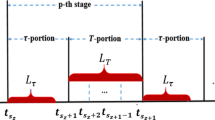Abstract
We consider systems which are globally completely observable and output-to-state stable. The former property guarantees the existence of coordinates such that the dynamics can be expressed in observability form. The latter property guarantees the existence of a state norm observer and therefore the possibility of bounding any continuous state functions. Both properties allow to conceptually build an observer from an approximation of an exponentially attractive invariant manifold in the space of the system state and an output driven dynamic extension. The proposed observer provides convergence to zero of the estimation error within the domain of definition of the solutions.
Similar content being viewed by others
References
Angeli D, Sontag E (1999) Forward completeness, unboundedness observability, and their Lyapunov characterizations. Syst Control Lett 38:209–217
Besançon G (1998) State affine systems and observer-based control. In: Proceedings of IFAC nonlinear control systems designs symposium, Enschede, The Netherlands, July 1998, pp 399–404
Chen C-T (1984) Linear systems theory and design. Holt (Rinehart and Winston), New York
Ciccarella G, Dalla Mora M, Germani A (1993) A Luenberger-like observer for nonlinear systems. Int J Control 57(3):537–556
Deheuvels P (1980) L'intégrale. Presses universitaires de France, Paris
Engel R, Kreisselmeier G (2002) A continuous-time observer which converges in finite time. IEEE Trans Automat Control 47(7):1202–1204
Filippov A (1988) Differential equations with discontinuous right hand sides. Mathematics and its applications, Kluwer, Dordrecht
Gauthier J-P, Kupka I (1994) Observability and observers for nonlinear systems. SIAM J Control Optim 32(4) 975–994
Gauthier J-P, Kupka I (2001) Deterministic observation theory and applications. Cambridge University Press, Cambridge
Gauthier J-P, Hammouri H, Kupka I (1992) A simple observer for nonlinear systems, application to bioreactor. IEEE Trans Automat Control 37:875–880
Hammouri H, de Leon Morales J (1991) On systems equivalence and observer synthesis. In: Proceedings of joint conference, Genoa, Italy, pp 341–347
Isidori A (1999) Nonlinear control systems II. Springer, Berlin Heidelberg New York
Jiang Z-P, Praly L (1998) Design of robust adaptive controllers for nonlinear systems with dynamic uncertainties. Automatica 34(7):835–840
Kazantzis N, Kravaris C (1998) Nonlinear observer design using Lyapunov's auxiliary theorem. Systems & Control Lett 34:241–247
Khalil HK, Esfandiari F (1993) Semiglobal stabilization of a class of nonlinear systems using output feedback. IEEE Trans Automat Control 38:1412–1415
Kreisselmeier G, Engel R (2003) Nonlinear observers for autonomous Lipschitz continuous systems. IEEE Trans Automat Control 48(3):451–464
Krener A, Isidori A (1983) Linearization by output injection and nonlinear observers. Syst Control Lett 3:47–52
Krener A, Respondek W (1985) Nonlinear observers with linearizable error dynamics. SIAM J Control Optim 23(2):197–216
Luenberger D (1964) Observing the state of a linear system. IEEE Trans Mil Electron MIL-8:74–80
Mazenc F, Praly L, Dayawansa WP (1994) Global stabilization by output feedback: Examples and Counter-Examples. Syst Control Lett 23:119–125
Nicosia S, Tornambè A (1989) High-gain observers in the state and parameter estimation of robots having elastic joints. Syst Control Lett 13:331–337
Sontag E, Wang Y (1996) New characterizations of input-to-state stability. IEEE Trans Automat Control 41(9)1283–1294
Sontag E, Wang Y (1997) Output-to-state stability and detectability of nonlinear systems. Syst Control Lett 29:279–290
Teel A, Praly L (1994) Global stabilizability and observability imply semi-global stabilizability by output feedback. Syst Control Lett 22:313–325
Teel A, Praly L (2000) A smooth Lyapunov function from a class-KL estimate involving two positive semi-definite functions. ESAIM: Control Optim Calc Var 5:313–367
Xiao M-Q, Krener AJ (2002) Design of reduced-order observers of nonlinear systems through change of coordinates. In: Proceedings of the 41st IEEE conference on decision and control
Author information
Authors and Affiliations
Corresponding author
Additional information
The work of A. Astolfi is partly supported by the Leverhulme Trust.
Rights and permissions
About this article
Cite this article
Astolfi, A., Praly, L. Global complete observability and output-to-state stability imply the existence of a globally convergent observer. Math. Control Signals Syst. 18, 32–65 (2006). https://doi.org/10.1007/s00498-005-0161-8
Received:
Accepted:
Published:
Issue Date:
DOI: https://doi.org/10.1007/s00498-005-0161-8



